
How Wachspress a hardware hacker from San Francisco, invented a device capable of converting sound into tactile sensations. Danilo De Rossi has engineered a "Smart Skin", this artificial dermis is capable of sensing pressure to varying degrees and can sense texture as fine as the bumps on a braille manuscript. Currently telephone sex has emerged. In a recent paper by Allucquere Rosanne Stone, "Sex and Death Among the Disembodied" she describes the process of constructing desire through a single mode of communication. In this process the participants draw on cultural codes to construct a scenario that compresses large amounts of information into a very small space.
To many the idea of electrosex and teledildonics seems repugnant, computer ethicist Joseph Weizenbaum would consider it anti human, and perhaps it is. Contemporary philosophers have pointed to progressive mechanisation of human culture and the future of sexual expression as a site of a potential cultural collision of immense dimensions.
The secondary social effects of technosex are potentially revolutionary. If technology enables you to experience erotic frissons or deep physical, social, emotional communion with another person, with no possibility of pregnancy or sexually transmitted disease, what then of conventional morality, and what of the social rituals and cultural codes that exist solely to enforce that morality? Is disembodiment the ultimate sexual revolution and/or the first step toward abandoning our bodies?
Adi Newton and Robert E. Baker
Bitstream
1992 Contempo (Electrosex and Beyond)